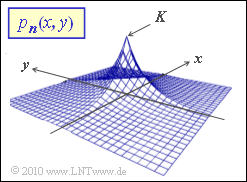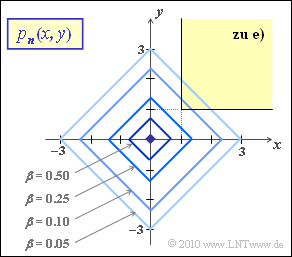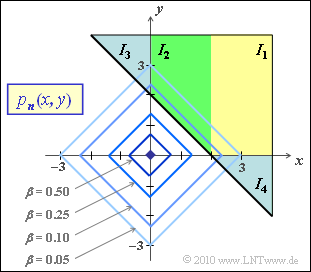Difference between revisions of "Aufgaben:Exercise 4.09Z: Laplace Distributed Noise"
| Line 98: | Line 98: | ||
Berücksichtigt ist die statistische Unabhängigkeit zwischen $n_1$ und $n_2$ sowie die Gleichheit $p_{\it n1}(x) = p_{\it n2}(y)$. Für $a = 1$ gilt: | Berücksichtigt ist die statistische Unabhängigkeit zwischen $n_1$ und $n_2$ sowie die Gleichheit $p_{\it n1}(x) = p_{\it n2}(y)$. Für $a = 1$ gilt: | ||
:$${\rm Pr} (n_1 > 1) = {1}/{2} \cdot \int_{1}^{\infty} {\rm e}^{- x} \,{\rm d} x = {1}/({2{\rm e}})\approx 0.184\hspace{0.3cm} | :$${\rm Pr} (n_1 > 1) = {1}/{2} \cdot \int_{1}^{\infty} {\rm e}^{- x} \,{\rm d} x = {1}/({2{\rm e}})\approx 0.184\hspace{0.3cm} | ||
| − | \Rightarrow \hspace{0.3cm} {\rm Pr} \left [ (n_1 > 1)\cap (n_2 > 1)\right ] = {1}/({4{\rm e}^2)}\hspace{0.1cm}\hspace{0.15cm}\underline {\approx | + | \Rightarrow \hspace{0.3cm} {\rm Pr} \left [ (n_1 > 1)\cap (n_2 > 1)\right ] = {1}/({4{\rm e}^2)}\hspace{0.1cm}\hspace{0.15cm}\underline {\approx 3.4\%}\hspace{0.05cm}.$$ |
[[File:P_ID2046__Dig_Z_4_9f.png|right|frame|Aufteilung des Integrationsbereichs]] | [[File:P_ID2046__Dig_Z_4_9f.png|right|frame|Aufteilung des Integrationsbereichs]] | ||
| − | '''(6)''' Die hier betrachtete Region ist in der folgenden Grafik farbig markiert. Die Regionen erstrecken sich aber nach rechts und oben bis ins Unendliche. Die gesuchte Wahrscheinlichkeit ergibt sich zu | + | '''(6)''' Die hier betrachtete Region ist in der folgenden Grafik farbig markiert. |
| + | *Die Regionen erstrecken sich aber nach rechts und oben bis ins Unendliche. | ||
| + | *Die gesuchte Wahrscheinlichkeit ergibt sich zu | ||
:$${\rm Pr} [ n_1 \hspace{-0.2cm} \ + \ \hspace{-0.2cm} n_2 > 2 ] =\frac{1}{4} \cdot \int\limits_{-\infty}^{+\infty} {\rm e}^{-|x|} \int\limits_{2-x}^{\infty}{\rm e}^{-|y|} \,{\rm d} y \,{\rm d} x = I_1 + I_2 + I_3 + I_4 \hspace{0.05cm}.$$ | :$${\rm Pr} [ n_1 \hspace{-0.2cm} \ + \ \hspace{-0.2cm} n_2 > 2 ] =\frac{1}{4} \cdot \int\limits_{-\infty}^{+\infty} {\rm e}^{-|x|} \int\limits_{2-x}^{\infty}{\rm e}^{-|y|} \,{\rm d} y \,{\rm d} x = I_1 + I_2 + I_3 + I_4 \hspace{0.05cm}.$$ | ||
| Line 121: | Line 123: | ||
Insgesamt ergibt sich somit: | Insgesamt ergibt sich somit: | ||
| − | :$${\rm Pr} \left [ n_1 + n_2 > 2 \right ] = {\rm e}^{-2} \cdot ({1}/{4} +{1}/{2} +{1}/{8} +{1}/{8})= {\rm e}^{-2} \hspace{0.1cm}\hspace{0.15cm}\underline {\approx | + | :$${\rm Pr} \left [ n_1 + n_2 > 2 \right ] = {\rm e}^{-2} \cdot ({1}/{4} +{1}/{2} +{1}/{8} +{1}/{8})= {\rm e}^{-2} \hspace{0.1cm}\hspace{0.15cm}\underline {\approx 13.5\%}\hspace{0.05cm}.$$ |
{{ML-Fuß}} | {{ML-Fuß}} | ||
Revision as of 13:16, 14 March 2019
Wir betrachten zweidimensionales Rauschen $\boldsymbol{n} = (n_1, n_2)$.
Die beiden Rauschvariablen sind „independent and identically distributed ”, abgekürzt i.i.d., und besitzen beide jeweils eine Laplace–Wahrscheinlichkeitsdichte:
- $$p_{n_1}(x) \hspace{-0.1cm} \ = \ \hspace{-0.1cm} K \cdot {\rm e}^{- a \hspace{0.03cm}\cdot \hspace{0.03cm} |x|} \hspace{0.05cm},$$
- $$ p_{n_2}(y) \hspace{-0.1cm} \ = \ \hspace{-0.1cm} K \cdot {\rm e}^{- a \hspace{0.03cm}\cdot \hspace{0.03cm} |y|} \hspace{0.05cm}. $$
- Die 2D–Wahrscheinlichkeitsdichtefunktion $p_{\it \boldsymbol{n}}(x, y)$ ist in der Grafik dargestellt.
- Zur Vereinfachung der Schreibweise werden hier die Realisierungen von $n_1$ und $n_2$ mit $x$ und $y$ bezeichnet.
Hinweise:
- Die Aufgabe gehört zum Kapitel Approximation der Fehlerwahrscheinlichkeit.
- Wir weisen Sie auf das interaktive Applet Zweidimensionale Laplaceverteilung hin.
- Das sich in Teilaufgabe (6) ergebende Integral muss aufgrund der Betragsbildung in mehrere Teilintegrale aufgespalten werden.
- Weiterhin gilt:
- $$\int_{0}^{\infty} x^2 \cdot {\rm e}^{-a \hspace{0.03cm}\cdot \hspace{0.03cm} x} \,{\rm d} x = {2}/{a^3} \hspace{0.05cm}.$$
Fragebogen
Musterlösung
- Die Fläche unter der WDF muss $1$ ergeben:
- $$\int_{-\infty}^{+\infty} p_{n_1}(x) \,{\rm d} x = 1 \hspace{0.3cm}\Rightarrow \hspace{0.3cm} \int_{0}^{+\infty} p_{n_1}(x) \,{\rm d} x = 0.5 \hspace{0.3cm} \Rightarrow \hspace{0.3cm} K \cdot \int_{0}^{\infty} {\rm e}^{- a \hspace{0.03cm}\cdot \hspace{0.03cm}x} \,{\rm d} x = - {K}/{a} \cdot \left [ {\rm e}^{- a \hspace{0.03cm} \cdot \hspace{0.03cm} x} \right ]_{0}^{\infty}= {K}/{a} = 0.5 \hspace{0.3cm}\Rightarrow \hspace{0.3cm} K = {a}/{2}\hspace{0.05cm}.$$
(2) Der lineare Mittelwert ist aufgrund der WDF–Symmetrie gleich 0.
Damit ist die Varianz $\sigma^2$ tatsächlich – wie bereits in der Fragestellung angegeben – gleich dem quadratischen Mittelwert:
- $$\sigma^2 = {\rm E}[n_1^2] = 2 \cdot \frac{a}{2} \cdot \int_{0}^{\infty} x^2 \cdot {\rm e}^{-a \hspace{0.03cm} \cdot \hspace{0.03cm} x} \,{\rm d} x = a \cdot {2}/{a^3}= {2}/{a^2} \hspace{0.05cm}. \hspace{0.2cm}{\rm Mit}\hspace{0.15cm}a = 1\text{:} \hspace{0.2cm}\hspace{0.1cm}\underline {\sigma^2 = 2 }\hspace{0.05cm}.$$
(3) Richtig ist der Lösungsvorschlag 1:
- Im ersten Quadranten ($x ≥ 0, y ≥ 0$) kann auf die Betragsbildung verzichtet werden. Dann gilt für die 2D–WDF:
- $$\boldsymbol{ p }_{\boldsymbol{ n }} (x,\hspace{0.15cm} y) = {a^2}/{4} \cdot {\rm e}^{- a \hspace{0.03cm}\cdot \hspace{0.03cm}x} \cdot {\rm e}^{- a \hspace{0.03cm}\cdot \hspace{0.03cm}y }= {a^2}/{4} \cdot {\rm e}^{- a \hspace{0.03cm}\cdot \hspace{0.03cm}(x+y)}\hspace{0.05cm}.$$
- Eine Höhenlinie mit dem Faktor $\beta$ gegenüber dem Maximum hat dann den folgenden Verlauf ($0 < \beta < 1$):
- $${\rm e}^{- a \hspace{0.03cm}\cdot \hspace{0.03cm}(x+y)} = \beta \hspace{0.3cm} \Rightarrow \hspace{0.3cm} x + y = \frac{{\rm ln}\hspace{0.15cm}1/\beta}{a} \hspace{0.05cm}.$$
- Die Grafik zeigt die Höhenlinien für $a = 1$ und einige Werte von $\beta$, die jeweils ein um $45^\circ$ gedrehtes Quadrat ergeben ⇒ die Höhenlinien sind also Gerade..
(4) Das hier betrachtete Wahrscheinlichkeitsereignis entspricht genau dem dritten Quadranten der oben skizzierten Verbund–WDF. Aufgrund der Symmetrie ist diese Wahrscheinlichkeit:
- $${\rm Pr}[(n_1 < 0) ∩ (n_2 < 0)]\hspace{0.15cm}\underline {=25\%}.$$
(5) Dafür kann mit der Verbund–WDF geschrieben werden:
- $${\rm Pr} \left [ (n_1 > 1)\cap (n_2 > 1)\right ] = {1}/{4} \cdot \int_{1}^{\infty} \int_{1}^{\infty}{\rm e}^{- (x+y)} \,{\rm d} x \,{\rm d} y == {1}/{2} \cdot \int_{1}^{\infty} {\rm e}^{- x} \,{\rm d} x \hspace{0.15cm} \cdot \hspace{0.15cm} {1}/{2} \cdot \int_{1}^{\infty} {\rm e}^{- y} \,{\rm d} y $$
- $$ \Rightarrow \hspace{0.3cm}{\rm Pr} \left [ (n_1 > 1)\cap (n_2 > 1)\right ] = \left [ {\rm Pr} (n_1 > 1)\right ] \cdot \left [ {\rm Pr} (n_2 > 1)\right ]\hspace{0.05cm}. $$
Berücksichtigt ist die statistische Unabhängigkeit zwischen $n_1$ und $n_2$ sowie die Gleichheit $p_{\it n1}(x) = p_{\it n2}(y)$. Für $a = 1$ gilt:
- $${\rm Pr} (n_1 > 1) = {1}/{2} \cdot \int_{1}^{\infty} {\rm e}^{- x} \,{\rm d} x = {1}/({2{\rm e}})\approx 0.184\hspace{0.3cm} \Rightarrow \hspace{0.3cm} {\rm Pr} \left [ (n_1 > 1)\cap (n_2 > 1)\right ] = {1}/({4{\rm e}^2)}\hspace{0.1cm}\hspace{0.15cm}\underline {\approx 3.4\%}\hspace{0.05cm}.$$
(6) Die hier betrachtete Region ist in der folgenden Grafik farbig markiert.
- Die Regionen erstrecken sich aber nach rechts und oben bis ins Unendliche.
- Die gesuchte Wahrscheinlichkeit ergibt sich zu
- $${\rm Pr} [ n_1 \hspace{-0.2cm} \ + \ \hspace{-0.2cm} n_2 > 2 ] =\frac{1}{4} \cdot \int\limits_{-\infty}^{+\infty} {\rm e}^{-|x|} \int\limits_{2-x}^{\infty}{\rm e}^{-|y|} \,{\rm d} y \,{\rm d} x = I_1 + I_2 + I_3 + I_4 \hspace{0.05cm}.$$
Aufgrund der Betragsbildung ist eine Aufspaltung in Teilintegrale vorzunehmen. Nach oben und rechts erstrecken sich alle Gebiete bis ins Unendliche. Aufgrund der Symmetrie gilt $I_4 = I_3$.
- $$I_1 = {1}/{4} \cdot \int_{2}^{+\infty} \hspace{-0.15cm}{\rm e}^{-x} \int_{0}^{\infty}\hspace{-0.15cm}{\rm e}^{-y} \,{\rm d} y \,{\rm d} x = {1}/{4} \cdot \int_{2}^{+\infty} {\rm e}^{-x} \,{\rm d} x ={1}/({4{\rm e}^2})\hspace{0.05cm},$$
- $$I_2 = {1}/{4} \cdot \hspace{-0.1cm} \int_{0}^{2} \hspace{-0.15cm}{\rm e}^{-x} \int_{2-x}^{\infty}\hspace{-0.15cm}{\rm e}^{-y} \,{\rm d} y \,{\rm d} x = {1}/{4} \cdot \hspace{-0.1cm} \int_{0}^{2} {\rm e}^{-x}\hspace{-0.1cm} \cdot {\rm e}^{x-2} \,{\rm d} x$$
- $$\Rightarrow \hspace{0.3cm}I_2 = {1}/{4} \cdot \hspace{-0.1cm}\int_{0}^{2} {\rm e}^{-2} \,{\rm d} x = {1}/({2{\rm e}^2})\hspace{0.05cm},$$
- $$I_3 \hspace{-0.1cm} \ = \ \hspace{-0.1cm} {1}/{4} \cdot \int_{-\infty}^{0} {\rm e}^{x} \int_{2-x}^{\infty}{\rm e}^{-y} \,{\rm d} y \,{\rm d} x = {1}/{4} \cdot \int_{-\infty}^{0} {\rm e}^{x} \cdot {\rm e}^{x-2} \,{\rm d} x = {1}/{4} \cdot \int_{-\infty}^{0} {\rm e}^{2x-2} \,{\rm d} x = \frac{{\rm e}^{-2}}{4} \cdot \int_{0}^{\infty} {\rm e}^{-2x} \,{\rm d} x = {1}/({8{\rm e}^2})\hspace{0.05cm},$$
- $$I_4 ={1}/{4} \cdot \int_{-\infty}^{0} {\rm e}^{y} \int_{2-y}^{\infty}{\rm e}^{-x} \,{\rm d} x \,{\rm d} y = ... = {1}/({8{\rm e}^2}) = I_3\hspace{0.05cm}.$$
Insgesamt ergibt sich somit:
- $${\rm Pr} \left [ n_1 + n_2 > 2 \right ] = {\rm e}^{-2} \cdot ({1}/{4} +{1}/{2} +{1}/{8} +{1}/{8})= {\rm e}^{-2} \hspace{0.1cm}\hspace{0.15cm}\underline {\approx 13.5\%}\hspace{0.05cm}.$$


